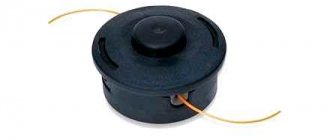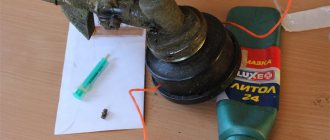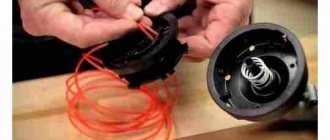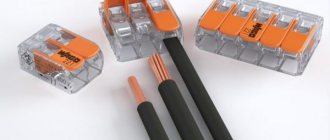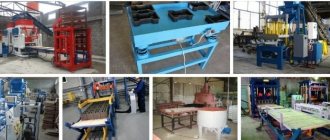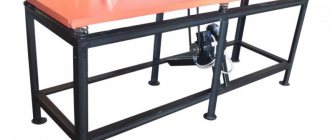A gasoline trimmer (gasoline trimmer, brush cutter) is an autonomous tool for mowing tall and coarse grass.
This manual device copes with weeds and even young growth of bushes or trees, but cuts the grass much more carefully than a gasoline lawn mower, and the cutting height depends entirely on the operator.
The petrol mower can also easily cope with wet grass and treat hard-to-reach areas without damaging tree trunks.
A gasoline trimmer differs from its electric and battery-powered counterparts:
- engine type;
- engine location;
- type of energy source.
What is a gasoline trimmer and its purpose?
A gasoline trimmer is a hand-held (wearable) tool designed for cutting grass and weeds with a trimmer head or a metal knife, as well as for cutting down bushes and young trees with a saw blade, if this is provided for by the trimmer design.
Purpose of a gasoline trimmer
- Trim the lawn in places where the lawn mower cannot reach (around trees and bushes, along walls and fences, on uneven surfaces and slopes).
- The trimmer is also designed for independently mowing all types of grass and weeds, cutting down bushes and young trees.
- For finishing mowing after the grass has been mowed with a tractor or self-propelled mower (various seeded and natural grasses).
A gasoline trimmer for cutting all types of grass (other names: brush cutter, brush cutter, hedge trimmer) involves selecting the appropriate knife or trimmer head - the grass can be tall, even, thick, or it can be already dead, tangled or thinned out. Accordingly, the knives are selected: metal hay or metal universal, light plastic or trimmer head. Also, using a trimmer, you can cut large weeds (with a weed knife), bushes, branches and young trees with a diameter of up to 14 cm (with a sawing disc). Gasoline trimmers or gas mowers are used by owners of personal plots (in cities, towns and villages), farms, forestries, road, municipal and railway services for mowing grass.
How to choose a grass trimmer and what parameters to consider
There is a lot of information on the Internet about how to choose the right grass trimmer. Each resource talks in its own way about the criteria that must be taken into account in order for the purchased instrument to satisfy the buyer’s needs. Buying a trimmer will not be difficult if you have the finances, but choosing the right model is much more difficult. What you need to know in order to choose the best trimmer option for your home, cottage, or cutting grass in the field, we’ll look into it further.
History of the petrol trimmer
- 1953 - British farmer William Thomas assembled the world's first gasoline trimmer, the Jetcut Hedgetrimmer.
- 1960 - the Japanese company ECHO produces the world's first backpack gasoline trimmer (back-mounted trimmer).
- 1966 - the ECHO company produces the first trimmer with a straight shaft (in the form in which we now know it).
- 1966 - the same Japanese company ECHO produces the world's first gasoline trimmer with a diaphragm carburetor and a sealed fuel system that allows the trimmer to operate in any position.
- 1990 - the ECHO company begins serially installing an electric starter on trimmers .
- 1992 - the same ECHO campaign begins production of a trimmer with a separate lubrication system , which allows the use of pure gasoline for refueling trimmers (not diluted with oil).
- 1994 - the ECHO company produces the most powerful gasoline trimmer with a two-cylinder boxer engine .
- 1999 - the Japanese company Shindaiwa produces the world's first trimmer with an extended rod for connecting a trimmer attachment to the trimmer (for cutting branches on a tree at a height of 4 m while standing on the ground).
- 2002 - the same company Shindaiwa produces the world's first 4-stroke trimmer (4-stroke brush cutter).
- 2009 - LEHR released the world's first trimmer with an engine powered by propane gas (environmentally friendly).
- 2010 - The Japanese company Maruyama (Maruyama) begins production of premium trimmers .
What you plan to mow with a trimmer is the main selection parameter
A good trimmer is not one that has a large reserve of power, but one that copes with the task as efficiently and productively as possible. To achieve such results, you need to decide what kind of grass you plan to mow with the purchased tool. This could be young ornamental grass on the lawn, which does not grow more than 10-15 cm in length. For such purposes, a low-power electric unit is suitable, which will not consume a lot of power, and at the same time effectively cope with the mowing of young and fresh grass.
If you plan to mow large and thick-stemmed grass, then for such cases you will need not just powerful, but also high-performance tools powered by gasoline engines. It is important to purchase gasoline trimmers when cutting grass outside a private home, so these are the units you need to choose.
This is interesting!
Keep in mind that electric and gasoline trimmers are divided into household and professional ones. They may have the same power parameters, but differ in permissible operating time. Household units should not be operated for more than 1 hour a day with breaks every 20-30 minutes. Professional lawn mowers are designed to work for 10-15 hours a day (exact data is indicated by the manufacturer in the technical description).
The future of the petrol trimmer
A robot mower with a gasoline trimmer (humanoid biomechanical robot), which during operation adapts to the existing mowing conditions (fully automatic). It works via GPS, a program previously entered by the owner (there are instructions in Russian) or via the mobile Internet. The operator, through a program installed on a computer or smartphone, can see through the “eyes” of the robot (on the screen), what it is doing, the situation around the robot and correct its actions. As tests have shown, the robot mows on its own very quickly - the revolutions and movements of the knife are equally fast, regardless of the load. At the same time, the knife accurately copies the surface of the area and, without the slightest nuisance, mows down trees, bushes, seedlings, pillars, corners, along walls, etc. But, if it is necessary, for example, to peer into a flower garden between flowers, then the operator from the computer takes control. hands and gives commands to the robot: the knife “a little forward”, “a little back”, “a little to the left”, “a little to the right”, a little faster”, etc. The robot mower and petrol trimmer work without slowing down around the clock until they complete exercise. The robot is equipped with a compact laser (which allows the robot to see in the dark, fog or smoke), a surveillance camera (with all-round viewing capability), an infrared sensor, two radars and eight ultrasonic sensors. At night, the side lights automatically turn on and the mowing area is illuminated (watch the video). You can install any gasoline trimmer on the robot - refueling is done without interrupting mowing from a 45-liter backpack tank. For an additional fee, the robot can talk and show feelings (joy, tenderness, resentment, anger). There is a button on the robot's chest to turn it off. You can buy a gasoline trimmer together with a robotic mower for the price of 5-6 good self-propelled lawn mowers. At the moment, the management of the manufacturing company is coordinating all legal formalities. The first batch of such robots should arrive in Russia next spring.
Gasoline trimmer in the near future
- The first petrol trimmer with a productivity of 0.3 to 1.5 ha/hour - a trimmer with an automatically extending rod at the extreme points of mowing (trimmer with a swing of 6.5 m) and with a knife like garden shears (knife grip width - 1.25 m ).
- The world's first trimmer with automatic gas - the petrol trimmer selects engine speed independently depending on the load on the blade (depending on the density of the grass and the speed of the operator). In the middle of the steering wheel is an automobile-type instrument panel.
- truly quiet trimmer with an active resonator (which pumps exhaust gases out of the cylinder) and a car-type muffler (silent trimmer).
- The world's first carbon trimmer for one-handed operation, petrol trimmer weighing 920 g.
- Cordless trimmer with a power of 13 kW (18 hp) , weighing 5.5 kg and operating time without recharging up to 10 hours (replaceable nano-batteries with a capacity increased several times are used).
What does a brush cutter consist of?
This apparatus consists of the following elements:
- engine;
- clutch;
- drive shaft;
- lever;
- bevel gearbox;
- cutting tool;
- protection;
- suspension system.
Engine
Lawn mowers are equipped with two- and four-stroke gasoline engines. Two-stroke engines have a higher power-to-weight ratio, but consume more fuel and are less reliable due to ineffective lubrication of the crankshaft bearings.
They run on a mixture of gasoline and special oil, and this mixture is not only fed into the cylinders, but also sprayed onto the bearings to lubricate them.
Four-stroke engines are noticeably heavier, but consume less fuel and are much more reliable, because the crankshaft bearings in them are lubricated by oil located in the engine sump. These engines run on pure gasoline , but every year they need to be filled with new motor oil.
The volume of the combustion chamber, regardless of the type of engine, is 25–60 cm3, which is comparable to the engine of a small scooter, and the power is in the range of 0.5–5 liters. With.
Also, any type of power unit is equipped:
- fuel tank;
- fuel pumping primer;
- air damper to change the operating mode;
- manual starter;
- carburetor;
- control handle with engine start button and speed controller.
Fuel tank
The tank is made of transparent plastic so that you can assess the amount of fuel mixture at a glance.
It is filled with pure gasoline for four-stroke engines and a mixture of fuel with special oil for two-stroke engines.
Plastic is resistant to petroleum products and relatively high temperatures , and also withstands mild impacts without damage.
Inside the tank there is a fuel supply tube through which gasoline or fuel mixture is supplied to the primer and carburetor.
Primer
The primer is designed to supply fuel to the carburetor before starting work, and after the engine is started, the mixture is sucked from the tank due to the vacuum created by the engine.
It is a pump with an inlet and outlet valve , and an elastic rubber bulge acts as a piston - when it is pressed, gasoline from the primer enters the carburetor, and when it is released, the straightening bulge creates a vacuum that sucks the mixture from the tank.
Air damper
The air damper restricts the flow of air during start-up mode, due to which the mixture of fuel and air in the engine cylinder becomes very rich and is more easily ignited by a weak spark .
After all, the power of the spark directly depends on the speed of rotation of the shaft, so during starting with a manual starter it is 20–40 less than after reaching operating speeds.
However, after starting, the over-enriched mixture burns ineffectively, so the rotation speed and power on the shaft are lower than the operating ones; therefore, the air damper is opened, ensuring normal air supply.
Recoil starter
A recoil starter consists of several elements and allows, using a rope equipped with a handle, to spin the engine crankshaft to a speed sufficient to produce a spark. The ratchet ensures the connection of the manual starter with the engine crankshaft at the time of starting, and after a set of revolutions it disconnects the mechanism from the engine.
Carburetor
The carburetor mixes air and a mixture of gasoline and oil in a certain proportion that best suits the operating mode of the engine.
An air damper (throttle), connected by a cable to the control handle, changes the amount of air supplied, but in operating mode the ratio of air to fuel is always the same and depends on the jets installed at the factory.
An air filter is installed above the carburetor, which filters out large dust and other particles dangerous to the engine. A fuel filter is installed in front of the carburetor, which filters out various contaminants. On some models, the filter is installed in the tank or in front of the primer.
Control knob
The control knob is mounted on the handle and secured with a bolt, so it can be removed if necessary. It is the main element with which the operator turns the engine on or off, and also regulates its speed depending on the load.
Clutch
This mechanism disconnects the shaft from the engine when the latter is idling, which allows you to safely carry the lawn mower over short distances without turning off the engine.
The clutch consists of:
- clamping pads;
- weights;
- springs;
- cups.
The weights and pressure pads, under the influence of centrifugal force, tend outward, towards the cup surrounding them , but the power of the springs is sufficient to prevent contact between them at idle.
As the engine speed increases, centrifugal force first forces them to touch the cup and then presses them so tightly that they transfer the rotational energy to the engine crankshaft without loss.
Drive shaft
The drive shaft is a flat steel rod mounted inside a steel or aluminum tube on several bearings. This part is one of the most important and most vulnerable , because if the shaft is even slightly deformed, then strong vibrations will occur during operation of the mower.
If the drive shaft initially has a curved shape, then inside it is not a rod, but a rope (cable) woven from steel wire, which does not cause strong vibrations, but is unsuitable for transmitting large torque.
Therefore, curved drives are installed only on low-power devices, and their main advantage is the ability to mow grass right under your feet.
There are models with a split or flexible drive shaft . The split shaft significantly reduces the size of the brush cutter required during transportation or storage, and the flexible shaft ensures grass mowing or shrub trimming in difficult conditions where it is difficult or even impossible to use a conventional device.
Lever
The handle is made in the shape of a semicircle or large horns and consists of five parts :
- collapsible fastening;
- left and right handsets;
- left handle;
- right handle.
By moving the handle along the drive shaft, the operator adjusts the mower for more comfortable work, then tightens the bolts of the collapsible fastening to fix it in the chosen place.
The left and right tubes can also be adjusted to fit your needs and then secured with bolts. The left handle is intended only for adjusting the position of the trimmer in space. The right handle, in addition to adjusting the position of the trimmer, is designed to control the engine.
Installed on it:
- engine on/off button;
- gas key;
- button to lock the gas button in the selected position.
If a left-handed person uses the lawn mower, then the right and left handles can be swapped; the button and key are located so that they are convenient to use with both hands. Some difficulties may arise with the gas key lock button , but it is rarely used, because it is necessary to regulate the operation of the engine in real time, preventing it from reaching maximum speed without load.
Bevel gear
The bevel gear combines the rotation axes of the drive shaft and the cutting tool. It is based on two bevel gears enclosed in a silumin housing, each of which is connected to its own shaft.
Long-term operation of this unit is possible only with a sufficient level of lubrication, which reduces friction between the gear teeth.
For lubrication, a hole is drilled in the housing through which a lubricant is inserted or pumped. To protect the mechanism from dust, the hole is closed with a screw, but some trimmers are equipped with a grease gun, so you will need a special syringe to lubricate them.
Cutting tool
Here are the main types of cutting tools:
- special plastic fishing line;
- knife with several blades (2–5);
- disc with pointed teeth;
- chain.
The line is wound onto a reel or head, then used to mow not too thick and dense grass.
The advantage of the fishing line is its low cost and the possibility of relatively quick replacement, as well as minimal damage caused by a collision with the ground or any obstacles.
The main disadvantage of the fishing line is severe injury to the grass , due to which its growth is greatly slowed down, so you cannot use the fishing line for harvesting green forage, because slowing down the growth of green mass will not reduce the number of mowings per season, and therefore the total volume of collected material.
Knives are made of metal or durable plastic. Plastic knives are mounted on a supporting plate, due to which they rotate freely around their axis and, when colliding with an obstacle, rotate and avoid damage.
After all, the impact energy is the product of mass and the square of the speed, and the mass of such a knife is small, while the impact speed is also damped by turning the knife around its axis.
There are also metal knives of this design, but most of them are stamped, that is, cut out of one sheet of metal .
Metal knives are much sharper and stronger than plastic ones, and if necessary, they can be sharpened, as we talked about here, so they can even be used for mowing down young growth of bushes and trees.
There are also knives for reeds, which are characterized by increased mass, due to which the kinetic energy stored in them is enough to cut the stem and maintain a high rotation speed, but they are used only in conjunction with powerful trimmers. For harvesting green fodder, knives with the maximum number of blades are best suited, because they do not chop, but rather discard the grass, placing it in the swath.
A serrated disc is less effective at cutting grass than any knife or line, so it is most often used for cutting branches and young trees. A chain cutting tool, in its traumatic effect, surpasses even fishing line, so it is used where it is necessary to clear a cluttered area of weeds.
Protection
The protection is a semicircular plastic part that covers the cutting tool and prevents the cuttings from being thrown towards the operator.
It is installed on the drive shaft, and for fixation, plastic clamps are used, which are tightened with screws.
Depending on the operating conditions, it can be moved along the shaft, and in some cases even removed, but the operating instructions for most trimmers prohibit working without protection. After all, the speed of particles flying out from under the knife or fishing line is very high , which means they can seriously injure the operator’s eyes.
Hanging system
The main task of the suspension system is to relieve the operator’s hands and transfer the weight of the trimmer to his shoulders. The cheapest systems are made of straps and are very inconvenient to use because they ineffectively distribute the weight of a rather heavy device.
More expensive systems are made of wide leather or fabric tapes with rigid inserts, due to which they distribute the load more effectively , which means the person working with such a system gets tired much more slowly. Therefore, some buyers who choose budget trimmers immediately purchase a new suspension.
Trimmer device
A classic trimmer consists of the following components:
- a gasoline or electric engine located at the top of the boom (the electric motor can also be located at the bottom of the boom) with all systems and mechanisms;
- the trimmer also consists of a straight drive shaft rod (or a curved cable drive rod) with a steering wheel and control handle;
- cutting equipment consisting of a gearbox (without a gearbox if the drive is cable), a knife or trimmer head, plastic protection and fastening parts.
Advantages of a gasoline trimmer
Autonomy (a gasoline trimmer is not tied to an outlet like an electric or battery-powered one) and high power, allowing you to mow heavier vegetation over relatively large areas.
Disadvantages of a gasoline trimmer
It produces a lot of noise, smoke and vibration, and to maintain a gasoline trimmer, you must have special knowledge and skills or use the services of a service center.
How to make a trimmer with your own hands
The simplest electric scythe can be built from plastic pipes, a small electric motor and a battery from a regular screwdriver. For this you will need:
- a plastic pipe with a diameter of 40 mm of sufficient length to make it convenient to mow the grass;
- corner made of plastic profile at 45 degrees;
- plug for a plastic pipe with a diameter of 40 mm;
- adapter 40/50 mm.
- connecting wires.
To make a simple battery-powered trimmer with a bottom-mounted engine from these materials, you need to:
- Drill holes in the plug to install the electric motor;
- Attach the motor to the plug and solder the wires to it. Install the assembled structure in the corner;
- Drill a hole for the switch in a convenient place on the pipe. Pass the wires coming from the engine through the pipe and attach the angle with the motor to its lower part.
- Install the switch button and terminals for connecting wires in series with the battery outputs.
- Attach the battery through the adapter to the pipe. It fits perfectly into a hole with a diameter of 50 mm.
- From the blades of a stationery knife, a metal plate with holes and a bolt with a diameter equal to the diameter of the motor shaft, construct the cutting element of our trimmer. Attach this structure to the shaft using a wire clamp.
- Cut out a protective casing from a plastic bucket and glue it to the corner with a hot glue gun.
The trimmer, fully capable of cutting grass, even with a hard and thick stem, is ready. For ease of use, you can come up with a simple handle.
Classification of trimmers
- A petrol trimmer is a household tool for removing grass, the main working part of which is the trimmer head. It contains a fishing line wound on a drum, the ends of which are brought out of the trimmer head. The trimmer bobbin rotates at speeds of up to 10,000 rpm. and under the action of centrifugal force the line straightens and cuts the grass. The trimmer head is often driven by a flexible metal cable.
- A petrol mower (motor mower) is a semi-professional petrol tool for mowing grass and weeds, the main working part of which is metal knives of various designs and purposes. Torque from the engine to the working element is transmitted, as a rule, by a straight metal shaft located in the bar of the lawn mower.
- A brush cutter is a professional tool (petrol trimmer) for sawing young trees and bushes up to 14 cm thick, the main working part of which is the saw blade. Brush cutters are characterized by high reliability, versatility and cost.
- An electric scythe is a household tool for cutting grass with a trimmer head or a metal blade, which uses an electrical network as a power source. The location of the electric motor can be either top or bottom. Advantages: ease of use and maintenance, silence, no vibrations and no gas costs. Disadvantages: the operating radius is limited by the length of the power cable.
- A cordless trimmer is a household tool for removing grass, usually with a trimmer head, that uses a rechargeable battery as a power source. The engine location and advantages compared to a gasoline trimmer are the same as those of an electric trimmer. Disadvantages: operating time is limited by the battery capacity.
Principle of operation
The rotation speed of the output shaft of the bevel gear, and therefore the cutting element installed on it, is 3–9 thousand rpm, thanks to which even round or square fishing line effectively cuts grass.
After all, the further the fishing line moves away from the center of the shaft, the higher its angular speed of movement , as a result, the inertia of the plant stems turns out to be too great, so the fishing line tears the upper part of the plant from the lower one.
Knives without sharp edges operate on the same principle, and knives with sharpened blades are designed for gentle cutting of grass, so if the blades are sharp enough, they can cut the grass as carefully as a lawn mower.
Due to the fact that the weight of the trimmer is distributed over the operator’s shoulders through the suspension system, he only changes the tilt of the cutting tool with his hands, visually assessing its position relative to the ground and adjusts the engine operating mode.
Even short-term operation of the engine at high speeds, but without load, or prolonged operation at maximum speeds with minimal load, greatly increases the wear of its parts . Therefore, the operator has to independently select the engine operating mode and control it using the corresponding key on the right handle.
Manufacturers of petrol trimmers
Gasoline trimmers are produced by such popular brands (such world-famous manufacturing companies) as STIHL (Calm) - Germany, Husqvarna (Husqvarna) - Sweden, VIKING (Viking) - Austria, Partner (Partner) - Sweden, MTD (MTD) - USA, ECHO (Echo) - Japan. Trimmers are also produced by: Makita (Makita) - Japan, SOLO (Solo) - Germany, AL-KO (Alco) - Germany, Oleo-Mac (Oleo-Mac) - Italy, Efco (Efko) - Italy, Jonsered (Jonsered) - Sweden, Hitachi (Hitachi) - Japan, Shindaiwa (Shindaiva) - Japan. Of particular note are trimmers assembled in the CIS - Ural, Taiga, Kedr, Minsk, Dnepr-M, Neva, Brigadir, as well as trimmers from China - Expert, Forte, Foresta, Sturm, Viper, Klever, Intertool, Patriot and many others.
What power should the units have or is it worth choosing high-power lawn mowers
The power of the units is indicated in kilowatts kW, and this parameter affects the performance of the tool. The more power, the higher the torque. Based on power, the units under consideration are divided into three types:
- Units with power parameters up to 1 kW are suitable for home use.
Moreover, these are often electric lawn mowers that cope with vegetation in the local area - Garden tools with a power rating of up to 1.5 kW are used for work not only in the local area, but also in the country.
Effectively cope with vegetation of different lengths and thicknesses. With power parameters up to 1.5 kW, not only gasoline, but also electric scythes are produced - With a power of over 1.5 kW to 2-3 kW, these are units that are designed to work in field conditions.
Copes with vegetation of varying lengths, thicknesses and densities. As a rule, electric trimmers with a power of more than 1.5 kW are not produced
With power, everything is simple - you need a trimmer for your home or garden, then select a tool with a rating of up to 1000 W. For serious work, units with a power of 1.5-2 kW are selected.
How many revolutions should the trimmer have?
The technical parameters for the equipment in question indicate the number of revolutions or spindle speed. The higher the rotation speed, the better. After all, at high speed, the cutting parts are capable of grinding vegetation of any thickness and density. However, for this, the tool must have an adequate power reserve, otherwise the cutting knives will bury themselves in the grass, which will lead to jamming of the engine. The rotation speed is measured in revolutions per minute.
- On low-power units, the parameter in question is up to 7000 rpm. The spindles of household electric lawn mowers rotate at this speed.
- Professional units develop spindle rotation speeds of up to 12,000 rpm. These are gasoline units with a sufficient power reserve of at least 2 kW
From the indicated values we can conclude that for home use a trimmer with a cutting element rotation speed of up to 7000 rpm is sufficient. For cutting grass in the field, devices with a rotation speed of 9000 to 12000 rpm are selected.
This is interesting!
Cutting steel discs are selected based on the rotation speed of the tool spindle.
Summing up and choosing the right grass trimmer, advice from experienced
Specialists who work with trimmers every day know not only all the rules for operating and repairing trimmers, but also how to choose them correctly. Only at the initial stage it seems that choosing a grass trimmer is a simple matter and does not require a special approach. In reality, everything is accurate, but vice versa. Choosing a trimmer requires an appropriate approach, which determines its performance, operation and service life. Experienced professionals recommend taking into account the following parameters when choosing gasoline and electric lawn mowers:
- Initially, you need to decide how often and where you plan to use the tool. If at home, then there is no point in buying gasoline units
- Select the appropriate power parameter, which determines not only the performance, but also the service life of the unit
- Cutting width and rotation speed - the larger these parameters, the faster the cutting. However, if you have never used a trimmer before, you will first need to learn how to operate this unit. The larger the cut parameter, the more difficult it is to control the tool. Many people do not take this into account, which ultimately causes rapid failure of the tool, which is especially important for electrical units
- After purchase, you will need to run in the tool. This applies not only to gasoline, but also to electric units. It is prohibited to operate the tool at full power under load without preliminary running-in.
You also need to consider the cost of the equipment. Household trimmers are cheaper than professional ones. A good tool will not be cheap, so it is better not to buy an average-quality professional trimmer if its price is below 10 thousand rubles. From 5 to 10 thousand rubles you can buy a good household trimmer, and professional models will cost over 10-15 thousand rubles.
What size fishing line (cord) should be on the selected trimmer
A parameter such as the thickness of the fishing line affects the ability of the tool to cut grass of different thicknesses. Units are produced that are designed to work with fishing line from 1.4 to 3.3 mm. The larger the cross-section of the fishing line, the thicker the grass it can cut. You cannot thread a large section of fishing line into the reel of a low-power trimmer, as this will lead to the equipment getting tangled in the grass and the motor jamming.
- For home use, a fishing line is used, the thickness of which is from 1.4 to 2 mm
- For cutting grass outside a private house and in the country, a fishing line with a cross-section of 2-2.7 mm is used
- If you mow grass in a neglected area, then use a durable cord with dimensions from 3 to 3.3 mm. If the fishing line cannot cope with the grass, then steel discs are used
The diameter of the line for the trimmer is selected not only by the power of the tool, but also by the type of head used. The heads indicate the permissible limits for line thickness.
What type of cutting equipment should be on the tool
The work of trimmers is to move cutting elements, which are of two types - flexible fishing line and steel knives. Each type of cutting system has its own advantages and disadvantages, as well as purposes for use. If you are wondering which trimmer to buy - with a fishing line or a steel disc, then the following description will help you decide:
- Line or cord - used for cutting grass on hilly terrain, as well as in the presence of various obstacles in the form of trees, fences, benches and other devices.
When the fishing line hits obstacles, it is torn off, but the gearbox and engine of the tool are not damaged. The disadvantage of cord is that it is not able to cope with dense vegetation, so in this case steel cutting knives are chosen - Steel cutting discs - used for cutting grass on a flat surface without existing obstacles.
The steel disc ensures an even cut, and units with this type of cutting element are used for cutting grass in the field.
If the purchased tool comes with a disk, this does not mean that it is not intended for working with cord. To do this, you will need to separately buy a head with fishing line, and, if necessary, use it by replacing the cutting elements.
Why tool weight should be taken into account when choosing
If a man does the work of mowing the grass, then the weight indicator does not play a special role. If a woman tidies up the local area, then the weight of the cutting tool has a direct effect. Electric lawn mowers weigh less than devices with internal combustion engines. The mass of the units ranges from 1.5 to 9 kg. Tools weighing 9 kg are usually lawn mowers with four-stroke internal combustion engines. It will be difficult even for men to operate a unit with such a weight, so the weight of the tool must be such that the operator can work with it for hours without getting tired.
- Electric trimmers weigh no more than 3-4 kg, and they should be chosen if you plan to work on the territory of a private house or cottage
- Gasoline units weigh 5-6 kg or more, which is due to the presence of a heavy internal combustion engine, as well as a fuel tank. It will be difficult for women to master such tools, so only men can use them
- Lightweight up to 3 kg - these are electric and battery-powered devices that are chosen for use by women and the elderly
The weight of the tool directly depends on its power, so the higher the power parameters, the more the trimmer weighs.



